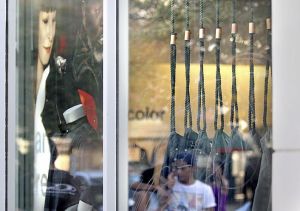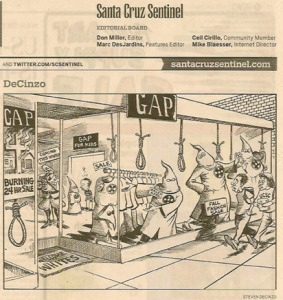At what point does “edgy” become offensive? Do social themes become diluted when they are integrated into promotional campaigns for commercial sales? Is poor taste relative to our cultural perspective or universal? And who gets to decide? As we’ve learned from both our studies and our experiences as consumers and humans, we each approach the answers to these challenging questions through our individual filters, our unique “image” as Kenneth Boulding’s 1956 iconic book The Image proposes. This image is formed via a complex formula of values, direct experiences and cultural appropriateness, but is there common ground, a place within social boundaries where we can all agree? It is a difficult area to define let alone predict, and inevitably as communicators, we can misstep.
Several days ago, the Gap, that iconic American clothing brand that recalls timeless style and easy nostalgia, landed squarely in this fuzzy gray zone of acceptability – and on the front page, above the fold, in our local daily paper, the Santa Cruz Sentinel. In promoting its ‘1969’ black denim jeans, the Gap’s corporate marketing team went with a civil rights theme, complete with black nooses for, um, hanging the jeans prominently in a window display. Next to the nooses was a photo of actor Michael Williams, an African American well known for his role as “Omar Little” in HBO’s “The Wire.” Elsewhere in the store, signage declared “Black is a color” and “Don’t be afraid of the dark.” Either of these two slogans could have driven its own campaign sans the racial symbolism: black is technically the absence of color, but the idea could generate some cool ‘cosmic black hole’ vibes; and, the second one conjures up spooky stories around the campfire – a very nice framing opportunity around a fall campaign. Yet corporate creative added a third message with the nooses that seems to color (pun intended) the other slogans unnecessarily with racial overtones: black is worthwhile, and dark equates scary. It’s not stated, but it does take us there when presented as a whole with Mr. Williams’ portrait and the aforementioned nooses.

The Gap window display in downtown Santa Cruz, California. Photo: Shmuel Thaler, Santa Cruz Sentinel
The gist of the local news story was that many community members were offended and upon inquiry with the store’s employees, at least one resident received agreement that the concept was “pretty terrible” but nothing was to be done since the concept came from corporate. A follow up story by a local NBC affiliate TV station reported that the store employees “quietly altered the way the ropes were attached to the jeans” eliminating the offensive “noose” visual. But the question of intent remains: was Gap genuinely trying to elevate the conversation of race as they promoted their ‘1969’ line of jeans? Or were they just trying to be visually clever for their young and hip target audience? Did it work? In a way, whether intended or not, it did.
The Sentinel reporter, Kara Guzman, checked in with University of California Santa Cruz psychology professor and researcher Anthony Pratkanis for his take on the display. Pratkanis, renown for his research on subliminal messaging and advertising, confirmed that controversial ad campaigns are popular with young audiences and can contribute to a brand’s image. He felt the concept was likely meant to be controversial. Guzman also spoke with Simba Kenyatta, a well-known and respected local community organizer and founder of Santa Cruz County Coalition to Overcome Racism. Kenyatta, who is African American, was not offended. Why? Because the knots on display were not “hangman knots.” He goes on to say “I have to pick my battles and this isn’t one of them.” He then describes what he endured growing up black in Indiana and his direct experiences with the race riots of the late 1960s. It was these experiences that have led Kenyatta, who is also the president of the local chapter of the NAACP, to teach his son about how to respond to a policemen and stay safe, and to watch him navigate the very real racism in this “progressive” town.
So what did the Gap achieve? Publicity? Check. Conversation around race? Check. The follow-up stories and the political cartoon by controversial artist DeCinzo (below), served to extended the conversation. Despite what our sensibilities tell us and the intent of the marketing concept, there can often be more to an issue than whether or not a choice is offensive. I, for one, am thankful for the conversation and prefer dialogue over silence every time. What do you think?
References
Boulding, K. E. (1956). The Image. Ann Arbor, MI: University of Michigan Press.
Gap store in Santa Cruz changes black jean display. (2014, September 24). KSBW.com. Retrieved from http://www.ksbw.com/news/central-california/santa-cruz/santa-cruz-gap-store-changes-its-hanging-black-jeans-display/28233058
Guzman, K. (2014, September 24). Gap display hits racial cord. Santa Cruz Sentinel, pp. A1, A4.
Guzman, K. (2014, September 24). Santa Cruz Gap’s new normal campaign: jeans, a T-shirt and a noose? Santa Cruz Sentinel. Retrieved from http://www.santacruzsentinel.com/santacruz/ci_26593255/santa-cruz-gaps-new-normal-campaign-jeans-t
Michael Kenneth Williams. (n.d.). IMDB.com. Retrieved from http://www.imdb.com/name/nm0931324/?ref_=ttfc_fc_cl_t11


5 Responses to Offensive Strategy